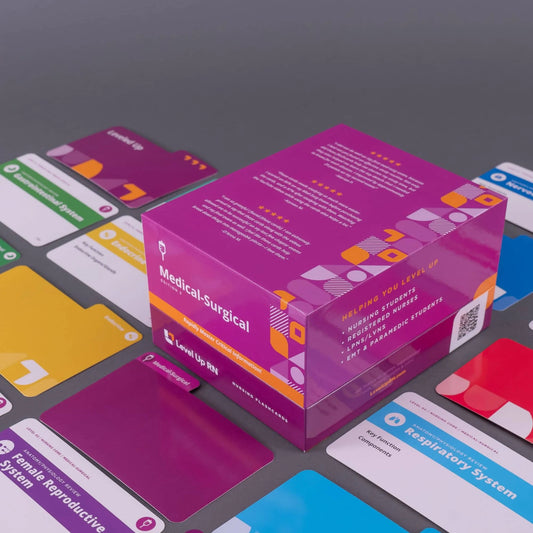Med-Surg - Musculoskeletal System, part 6: Osteomyelitis, Gout
Updated: Cathy ParkesOsteomyelitis, including the risk factors, signs/symptoms, diagnosis, and treatment of this disorder. Gout, including the pathophysiology, signs/symptoms, labs, diagnosis, treatment, and patient teaching associated with gout.
Full Transcript: Med-Surg - Musculoskeletal System, part 6: Osteomyelitis, Gout
Full Transcript: Med-Surg - Musculoskeletal System, part 6: Osteomyelitis, Gout
Hi. I am Cathy with Level Up RN. In this video, I am going to talk about osteomyelitis as well as gout. At the end of the video, I'm going to give you guys a quiz to test your understanding of some of the key concepts I'll be covering in this video. So definitely stay tuned for that. And if you have our Level Up RN, medical, surgical nursing flashcards, definitely pull those out so you can follow along with me.
Osteomyelitis is a bone infection.
And as a wound care nurse at my hospital, this is something I see a lot because a key risk factor for osteomyelitis is a severe wound. So if a wound gets deep enough such that the bone is exposed, it becomes contaminated, and it's very likely that the patient will have osteomyelitis.
Other risk factors include recent trauma, such as an open fracture, orthopedic surgery and systemic diseases such as diabetes. So patients with diabetes often end up with diabetic foot ulcers, which can become infected and lead to osteomyelitis.
So in terms of signs and symptoms, patients will likely have bone pain, redness, swelling, fever and an increase in white blood cells.
Diagnosis can be done with an X-ray and MRI, a bone scan, as well as a bone biopsy.
In terms of treatment, long-term antibiotic therapy is usually indicated for osteomyelitis. Sometimes this can include oral antibiotics, but often it requires IV antibiotics, so patients with osteomyelitis will often get a pic line so that they can receive IV antibiotics over a long period of time, four to six weeks or even longer. In addition, in some cases, the patients may require surgical debridement of the bone, so they need to go into surgery where they cut out part of the bone that is infected.
Next, let's talk about gout, which is a metabolic disorder that causes hyperuricemia or an increase in uric acid levels.
So this in turn causes the formation of these uric acid crystals, or tophi that become deposited in the joints.
So signs and symptoms of gout include joint pain, redness, swelling and these tophi, which appear as kind of red enlarged, painful areas on the joints. So in particular, gout typically affects the great toe, so it's not always the case, but it is often the case that the great toe is disproportionately affected by gout.
So in terms of labs, labs will show an increase in uric acid levels. Also, if we do an arthrosynthesis and remove some of the synovial fluid from the joint, it will show urate crystals and then an X-ray and a CT scan can also be helpful in diagnosing gout.
In terms of treatment, NSAIDs and ice packs can assist with pain control. In addition, colchicine is a key medication that is used for an acute gout attack, so it decreases the pain and inflammation in that acute gout attack. And colchicine is actually the origin story for our cool chicken that I talk about often and you'll see in our flashcard decks.
So cool chicken was a way to remember colchicine, because if you look at colchicine, it looks like cool chicken. So I made up a story of a guy with a chicken and his friend comes up and he's like, "Cool Chicken Man." And then the chicken like picks that guy's gouty toes and he's like, "Oh, you're chicken picked my gouty toe." And that's just my little silly story to help you remember meds because you got to have something to help you remember all these medications. So that's colchicine.
For chronic gout, we can prescribe the patient allopurinol as well as probenecid, and then we want to provide patient teaching as well for gout.
So we should advise our patients to avoid alcohol. They should avoid purine-rich foods such as red meat and organ meat, shellfish and fructose drinks. We should also advise our patients to avoid starvation dieting, which can trigger gout, and they should increase their fluid intake and reduce stress if possible.
All right, it's time for quiz. I have three questions for you. First question, blank is a bone infection that often requires long-term antibiotic therapy. The answer is osteomyelitis. Question number two, gout is characterized by excess blank levels. The answer is uric acid. Question number three, what medication is used for an acute gout attack? The answer is colchicine or cool chicken, like my little story.
All right. I hope this video has been helpful. Take care and good luck with studying.
Increase in uric acid levels. And it causes uric acid crystals to be [inaudible]. And these crystals will be deposited in the joints and these uric.


